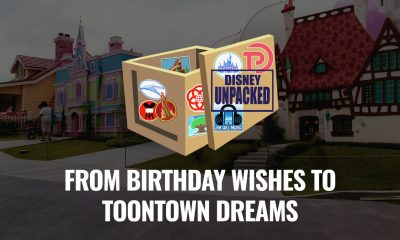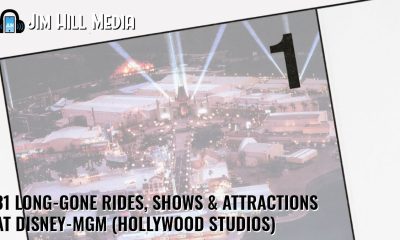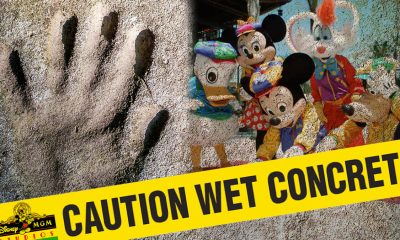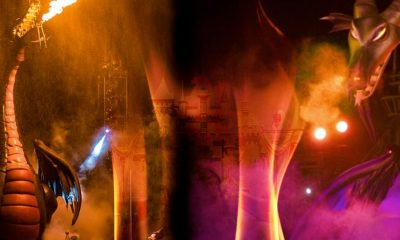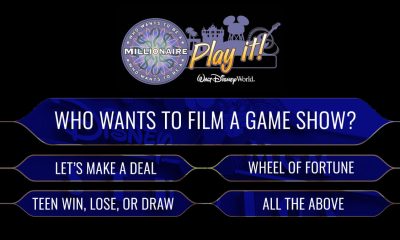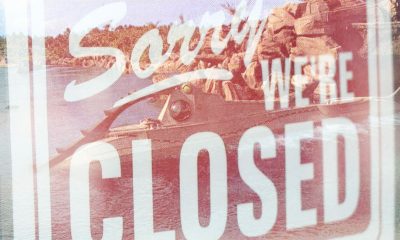Theme Parks & Themed Entertainment
An Elephant’s Tale – Why Was Big Red Removed from “Kilimanjaro Safari”
They say “an elephant never forgets.” Well, neither does Jim Hill. In this classic from the archive, he fills you in on the bizarre fate of Big Red, that enormous fake pachyderm who used to play such a crucial part in the “Kilimanjaro Safaris” ride at Disney’s Animal Kingdom theme park.
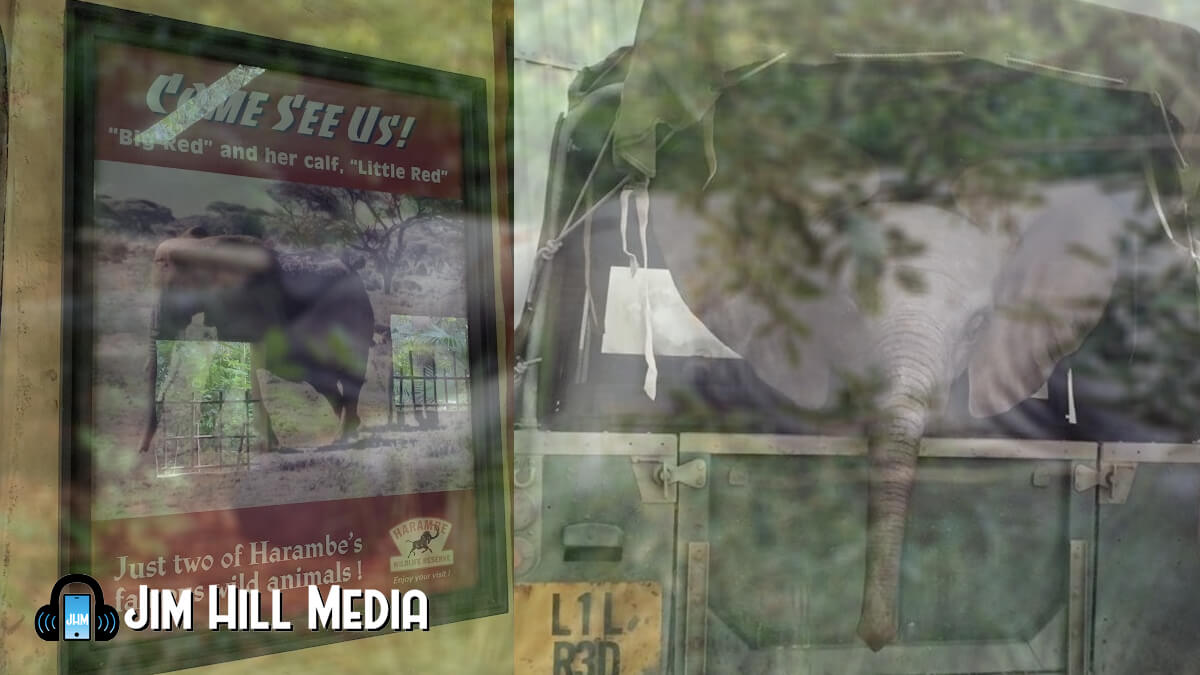
One of the more fun parts of doing a column like this is that nice people — like yourselves — will come forward with weird bits of information that I didn’t have access to. Their mission: to help fill in the blanks on parts of the story that I may have inadvertently missed out on. Recently, a number of Walt Disney World cast members were nice enough to come forward and share their memories of the “Dragon Rocks” section of Animal Kingdom’s Discovery River Boat ride.
I’m particularly grateful to Skipper John, who had sent along a pointer to a web site that he had started to pay tribute to DAK’s defunct Discovery River Boat ride; unfortunately, his web site is no more. But while perusing Skipper John’s web page when it was still up, I got a real kick out to finally being able to read the spiel that the Imagineers had crafted for this section of DAK’s Discovery River Boat ride. I just love that groaner of an explanation as to why the dragon was blowing fire at the guests: “Yes, he seems unhappy to be awakened … must be because he’s been working nights.”
“Discovery River Boat Ride” – Why Were the “Dead” Knights Removed?
But, for me, the most interesting piece of mail that I got last week was this note from Michael S. He claims that — during those cast-member-only previews that were held at DAK back in March 1998 — that he actually got to see all of that nasty looking armor that E.B. Effects built for Disney. That — when Michael and his wife took their very first voyage down Discovery River — that all those beaten up pieces of armor were already in place around the mouth of the cave.
The way Michael S. describes it: “The knights were right in front of the cave. Dangling, floating, just in general dead. It was very disturbing, but very cool.”
Now for the really intriguing part: The very next week, when Michael went back to DAK and re-rode the Discovery River boat ride, all the armor had been removed.
So what happened here?
If the Imagineers had already gone to all the trouble of putting these props in place around “Dragon Rocks,” then why did Disney suddenly decide to pull the knights out of the park?
The explanation is simple, folks: The Mouse has a real squeamish streak.
By that I mean, the Walt Disney Company is especially concerned with elements of its attractions that may offend theme park goers. Which is most likely why Mickey said “Nighty Night” to the knights.
Removal of Big Red on “Kilimanjaro Safari”
Think that’s an over-simplification? Then let’s talk about Big Red, the big fake dead mother elephant that Disney pulled out of Animal Kingdom’s Kilimanjaro Safari attraction just weeks prior to that theme park’s grand opening. All because Big Red’s presence supposedly really spooked the kiddies.
So why exactly did this ersatz elephant really get the hook? A better question might be: What was a giant faux pachyderm corpse doing in this DAK attraction in the first place?
Disney’s Animal Kingdom’s Approach to Conservation
To answer this, you have to understand that — back when the Imagineers were initially designing Disney’s Animal Kingdom — they were honestly hoping to use this new WDW theme park to help educate people about conservation. However, recognizing that the Epcot approach (I.E. sugar-coating an attraction’s key concepts, then cramming them down the guest’s throat) wasn’t exactly working, the guys at WDI decided to take a different tact.
This time around, the Imagineers’ goal was try and be subtle. To fold important information about conservation right into the very plot of the attraction. All with the hope that — as guests rode through the ride — they’d somehow get a clue.
“Kali River Rapids” – Rain Forest Destruction
This is why — as guests float through DAK’s “Kali River Rapids” — they suddenly encounter that stretch of fake, burned out rain forest. The idea that these WDW visitors are supposed to get (particularly as they narrowly miss being crushed by that teetering logging truck) is that “Cutting down the rain forest is bad.”
Okay, I’ll admit it. This is not exactly subtle storytelling. The point is that the Imagineers meant well. That — by including this overly grim sequence in DAK’s “Kali River Rapids” — they were honestly trying to find an entertaining way to teach theme park visitors about the merits of conservation. (Whether or not anyone actually remembers this message after the second half of Kali River Rapids — where they’re almost drowned like rats — remains to be seen. Anyway …)
Dangers of Poaching
This brings us back to the Big Red story. When mapping out possible story lines for DAK’s Kilimanjaro Safaris attraction, the Imagineers struggled to find a way to make guests aware of the dangers of poaching. After knocking around a number of ideas, these guys finally decided to borrow a page from “Bambi.”
You remember “Bambi,” don’t you? The Disney film that taught us all that “Hunting was bad” by killing off Bambi’s mother? Well, WDI decided to use the very same plot device to nail home the “Kilimanjaro Safaris” underlying message.
The Story of Big and Little Red – “Kilimanjaro Safari”
This is why — once you enter the queue area for “Kilimanjaro Safari” — you’re constantly fed information about Big and Little Red. While telling guests about all the other animals that they’re about to see, the overhead monitors and voice-over narration in the pre-show — every so often — also mentions KS’s newest addition: the cute baby calf — Little Red — that Big Red recently gave birth to.
This seemingly minor plot thread continues to weave through the narrative of the first two thirds of DAK’s “Kilimanjaro Safaris” ride. As your driver takes your vehicle through all of the other animal enclosures, he repeatedly checks in with the attraction’s pre-recorded airborne naturalist — you know, that woman that’s supposedly flying over the game preserve in a plane — always asking “Have you seen Big Red yet?”
The rest of the attraction’s story line is just as carefully laid out. The off-hand radio message that suggests that there may be poachers lurking about. The back gate to the game preserve that seems to have been busted in.
So now your driver finally takes you through the elephant paddock (where — if you’re lucky — you actually get to see a pachyderm or two) where you begin looking for Big Red and Little Red. Only the mother and child elephant are nowhere to be seen. So your driver continues on, taking you past the lions’ den …
When suddenly your driver spies it! Big Red’s enormous bloody corpse off by the side of the road (partially obscured by tall grass). Since her tusks have sawn cut off, this is obviously the work of poachers. Your driver quickly radios in a report, and is immediately ordered to give chase.
This was the moment that the Imagineers had hoped would be seen as “Kilimanjaro Safaris”‘s thrilling finale. The high speed pursuit of Big Red’s killers (highlighted by the poachers actually firing a few rounds from a machine gun at your vehicle). Your jeep avoiding erupting geysers as you chase the criminals up a not-so-dry river bed.
“Kilimanjaro”‘s climax comes when we catch a quick glimpse of the authorities, who have successfully captured the poachers as well as rescuing Little Red. As we wave good-bye to our new Audio Animatronic baby elephant friend, we’re told that — as a reward for helping to capture these criminals — we’re now going to be given access to the most exclusive part of Harambe’s game preserve: the Gorilla Falls research station. As we exit our jeep, we’re told to just follow the signs to our next adventure.
Complaints About Big Red
On paper, this sounds like an exciting if fairly innocuous to end the attraction, right? Well, imagine WDI’s dismay when they actually began cycling WDW cast members and annual passholders through DAK’s “Kilimanjaro Safaris” ride and found that they were getting dozens of complaints about the dead Big Red.
What exactly was the guests’ problem with the faux elephant corpse? Well, where WDI seems to have miscalculated with DAK’s “Kilimajaro Safaris” ride was that — right up to the attraction’s finale — every other animal that WDW visitors had seen had been real. Not Audio Animatronics. But really-for-real zebras, gazelles and hippos. All roaming free.
So now — in the closing moments of the show — the “Kilimanjaro Safaris” vehicle suddenly rolls past what looks like an authentic dead elephant. Which is why most of the children on board the jeep (as well as some of the more gullible adults) immediately burst into tears. Because a really-for-real animal had seemingly been killed.
Just like Bambi’s mother.
Typical of the comments heard in “Kilimanjaro Safaris”‘s off-load area was this line: “I can’t believe that they actually let the poachers kill that elephant. I’m never going on that ride again.”
It was the latter portion of that guest’s comment that particularly concerned the Imagineers. For they were really counting of “Kilimajaro Safaris” re-ride-ability (I.E. due to the unpredictable nature of all of the animals on display in DAK’s signature attraction, WDW guests were virtually guaranteed a different experience every time they rode the ride … which — hopefully — would translate into guests riding “Kilimanjaro Safaris” two or three times over the course of their WDW vacation) to help put WDW’s newest theme park on the map.
But — if “Kilimanjaro Safaris”‘s finale was already putting a bad taste in WDW guests’ mouths after their very first ride through the attraction — obviously something had to be done to fix this situation. And fast.
The only problem was that “Kilimanjaro Safaris”‘s slender plot line virtually hinged on that awful moment where Big Red’s death was revealed. Without that moment, everything that followed — the pursuit of the poachers up the not-so-dry river bed, etc. — made absolutely no sense. And it wasn’t like the Imagineers actually had the option of redoing the attraction at this point. Disney’s Animal Kingdom theme park was due to open to the public in less than four weeks.
The “What to do about the dead elephant?” question flew up the Disney chain of command until it landed on the desk of the company’s CEO, Michael Eisner. Eisner — who had been a big fan of DAK’s conservation message — was obviously reluctant to remove the Big Red sequence. He felt that the powerful image of that dead mother elephant lying by the side of the road gave WDW visitors a poignant reminder of the real cost of poaching.
But then there were all these complaints that DAK Guest Services was reportedly receiving from all those angry parents whose children had supposedly been traumatized by glimpsing the dead Big Red near the end of “Kilimanjaro Safaris.” Surely Eisner couldn’t ignore all these negative comments. After all, Disney World resort’s family friendly image might be at stake (not to mention the $800 million that the company had just invested in the construction of WDW’s newest theme park).
Taking a Lesson from “Bambi”
Not sure exactly what he should do, Eisner hemmed and hawed for a couple of days. Finally — just three weeks prior to DAK’s grand opening — one of Michael’s minions actually watched “Bambi” and learned the real secret behind the film’s powerful anti-hunting message. Enlightened, the flunky quickly shared this crucial bit of info with his boss:
Yes, “Bambi” is a memorable and powerfully moving motion picture because they shoot Bambi’s mother. But the important thing to remember is Bambi’s mom is killed off-camera. You hear the shot, but never actually see the mama deer go down. Her death is implied.
Eisner was thrilled when he got this news (for it meant that no expensive, last minute fixes for DAK’s signature attraction were necessary). He immediately told the Imagineers to pull the fake dead mother elephant out of “Kilimanjaro Safaris” and to rewrite the attraction’s script so that Big Red’s death is not seen but implied.
Minor Change to “Kilimanjaro Safari”
This seemingly minor series of changes virtually eliminated all guest complaints about DAK’s “Kilimanjaro Safaris” ride. True, due to the deliberately vague language that the drivers now use while taking their vehicle full of WDW visitors through the attraction’s finale (“Big Red is down!” rather than the previous, more specific “Big Red has been shot!”), some guests get off the ride and have absolutely no idea what has just happened. All they know is that they were enjoying looking at some African animals … and then — suddenly — their jeep sped up.
But this — as far as Michael Eisner was concerned — was the sort of vague guest complaint that the Walt Disney Company could happily live with. Which is why DAK’s “Kilimanjaro Safaris” opened on April 22, 1998 with its dead Big Red hidden well out of sight somewhere backstage. (As I mentioned previously, this enormous fake elephant corpse is probably sharing a shelf in some WDW warehouse with “Dragon Rocks”‘s dead knights.) The attraction has been running — virtually unchanged — ever since then.
More Changes to Disney Attractions?
Mind you, this isn’t the first time that the Imagineers were forced to change a WDW attraction because of guest complaints about excessive gore. Remind me sometime to tell you guys about the wardrobe change that WDI was forced to make to Disney-MGM Studio’s “Great Movie Ride.” Does anyone else out there remember when your tram driver used to “bleed” when he or she get shot?
History
The Super Bowl & Disney: The Untold Story Behind ‘I’m Going to Disneyland!’

One of the highlights of the Super Bowl isn’t just the game itself—it’s the moment when the winning quarterback turns to the camera and exclaims, “I’m going to Disney World!” This now-iconic phrase has been a staple of post-game celebrations for decades. But where did this tradition begin? Surprisingly, it didn’t originate in a stadium but at a dinner table in 1987, in a conversation involving Michael Eisner, George Lucas, and aviation pioneers Dick Rutan and Jeana Yeager.

The Unlikely Beginning of a Marketing Sensation
To understand the origins of this campaign, we have to go back to December 1986, when the Rutan Voyager became the first aircraft to fly around the world without stopping or refueling. Pilots Dick Rutan and Jeana Yeager completed the nine-day journey on December 23, 1986, flying over 26,000 miles before landing at Edwards Air Force Base. Their historic achievement earned them national recognition, and just days later, President Ronald Reagan awarded them the Presidential Citizen Medal at the White House.
Meanwhile, Disney was gearing up for the grand opening of Star Tours at Disneyland, set for January 12, 1987. Following its usual playbook of associating major theme park attractions with real-world pioneers, Disney’s PR team invited astronauts Gordon Cooper and Deke Slayton to the launch event. But in a twist, they also invited Rutan and Yeager, who were still making headlines.

A Dinner Conversation That Changed Advertising Forever
After the Star Tours opening ceremony, a private dinner was held with Disney CEO Michael Eisner, George Lucas, and Eisner’s wife, Jane. During the meal, Eisner asked Rutan and Yeager, “You just made history. You traveled non-stop around the planet on a plane without ever refueling. How are you ever going to top that, career-wise? What are you two gonna do next?”
Without hesitation, Jeana Yeager replied, “Well, after being cramped inside that tiny plane for nine days, I’m just glad to be anywhere else. And even though you folks were nice enough to fly us here, invite us to your party… Well, as soon as we finish eating, I’m gonna go over to the Park and ride some rides. I’m going to Disneyland.”
Jane Eisner immediately recognized the power of Yeager’s statement. On the car ride home, she turned to Michael and said, “That’s a great slogan. I think you should use that to promote the theme parks.” Like many husbands, Michael initially dismissed the idea, but Jane persisted. Eventually, Eisner relented and pitched it to his team.
The Super Bowl Connection
With Super Bowl XXI just around the corner, Disney’s PR team saw an opportunity. The game was set for January 25, 1987, at the Rose Bowl in Pasadena—just miles from Disney Studios. What if they convinced the winning quarterback to say, “I’m going to Disneyland” live on-air?
Disney quickly struck a deal with both quarterbacks—Phil Simms of the New York Giants and John Elway of the Denver Broncos—offering each $75,000 to deliver the line if their team won. Simms led the Giants to victory, making history as the first athlete to say, “I’m going to Disney World!” on national television.
A Marketing Triumph
That year’s Super Bowl had the second-highest viewership in television history, with 87 million people watching Simms say the famous line. The next day, Disney turned the clip into a national commercial, cementing the phrase as a marketing goldmine.
Since then, “I’m going to Disneyland” (or Disney World, depending on the commercial) has been a staple of championship celebrations, spanning the NFL, NBA, and even the Olympics. What started as a casual remark at dinner became one of the most successful advertising campaigns in history.
A Lasting Legacy
Jane Eisner’s keen instinct and Disney’s ability to act quickly on a great idea created a tradition that continues to captivate audiences. The “I’m going to Disneyland” campaign remains a testament to the power of spontaneous inspiration and smart marketing, proving that sometimes, the best ideas come from the most unexpected places.
To learn more about Disney’s ties to the world of sports, check out I Want That Too: A Disney History and Consumer Product Podcast.
Television & Shows
How the Creators of South Park Tricked A-List Celebrities to Roast Universal – “Your Studio & You”
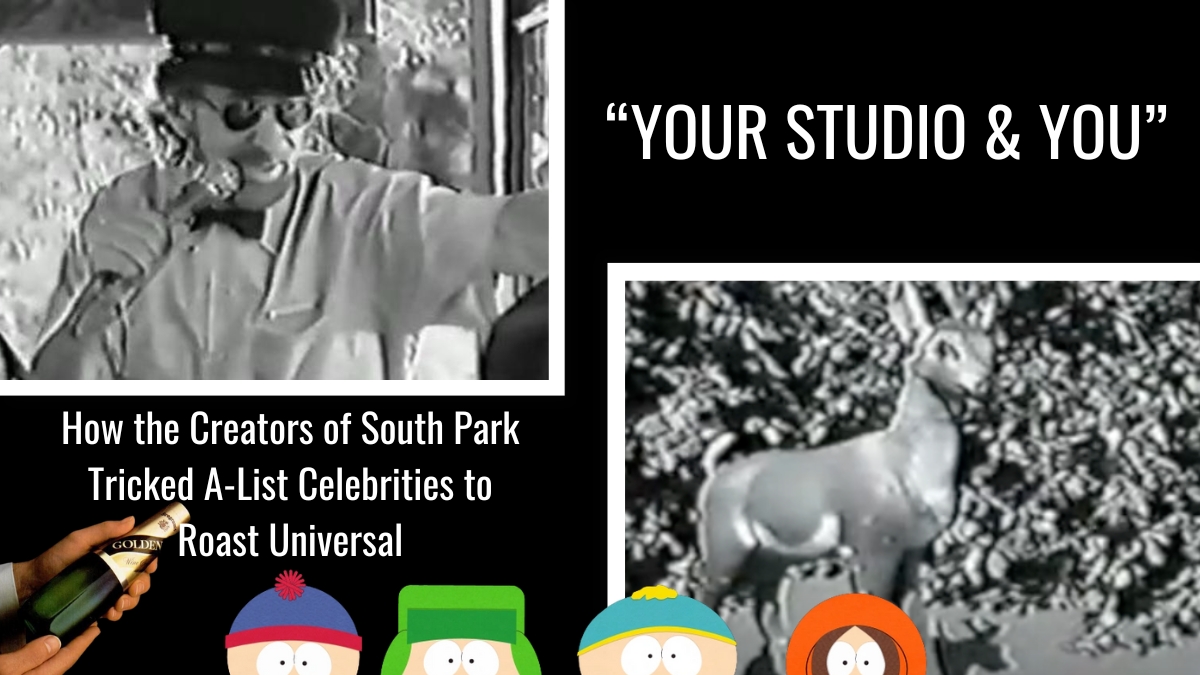
Universal Studios has a rich and storied history, but few moments are as peculiar—and as hilariously cutting—as the creation of Your Studio & You. This 14-minute parody film, commissioned in 1995 to celebrate Universal’s new ownership under Seagram’s, brings together an all-star cast, biting humor, and the unmistakable comedic fingerprints of Matt Stone and Trey Parker.
Long before South Park debuted on Comedy Central in 1997, Stone and Parker were already carving out a reputation for their irreverent style, and Your Studio & You perfectly encapsulates their knack for turning even the most corporate project into something delightfully subversive.
Matt Stone & Trey Parker Before South Park
Stone & Parker were already known out in Hollywood as funny guys. Thanks largely to “The Spirit of Christmas,” which was this video greeting card that they’d crafted for a Fox executive – who then distributed this infamously funny thing (which had Our Lord Jesus Christ & Santa Claus literally duking it out for the holiday affections of Cartman, Kenny, Stan & Kyle) to friends & family.
This was the early 1990s. No internet. Each copy of “The Spirit of Christmas” was made on VHS tape and then mailed. Went viral the old-fashioned way. It’s rumored that George Clooney made over 300 copies of “The Spirit of Christmas” and passed these VHS taps along to friends and family.
Things didn’t move as fast as they do today. “The Spirit of Christmas” still became a sensation out West.
Zucker Brothers
Matt & Trey also had other supporters in the entertainment industry. Among them David Zucker, who was one of the members of ZAZ (i.e., Zucker Abrahams Zucker), the talented trio that made “Airplane!” in 1980, “Top Secret!” in 1984 and the three “Naked Gun” movies.
- The original “Naked Gun” in 1988
- “Naked Gun 2 & 1/2 : The Smell of Fear” in 1991
- and “Naked Gun 33 & a 1/3: The Final Insult” in 1994
All five of these parody films had been made for Paramount Pictures. But in the Late Winter / Early Spring of 1995, Universal had persuaded the Zucker Brothers to come over and set up shop in a bungalow on their lower lot. With the hope that – at some point further on down the line – David & his brother Jerry would start making funny films for Universal.
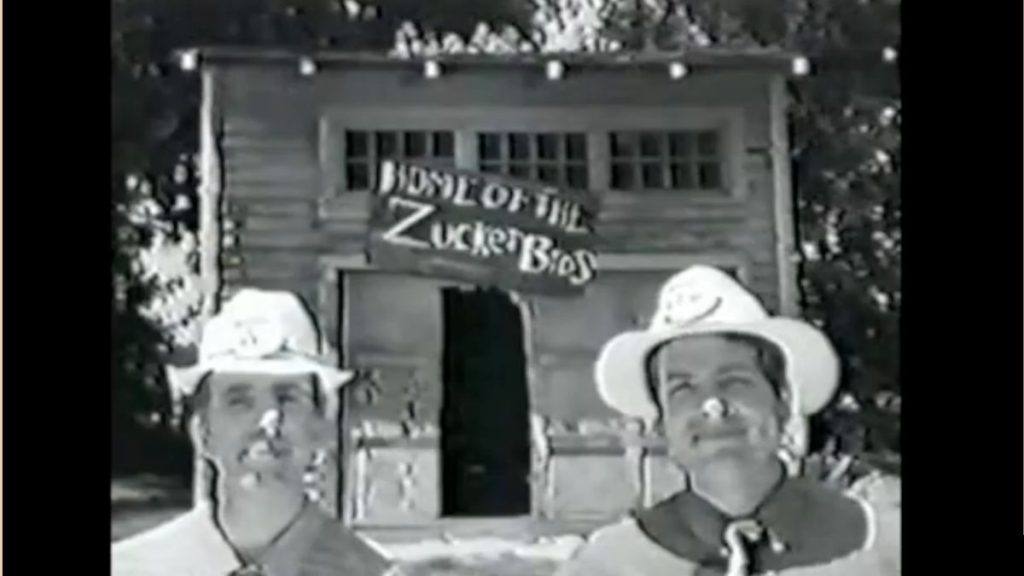
And it’s during this same window of time (We’re now talking April of 1995) that news breaks that Seagrams (Yep, the adult beverage company. Who – at the time – was making an absolute fortune on the sales of wine coolers) was about to buy a majority stake in MCAUniversal. We’re talking control of 80% of that company’s stock. Which would effectively make Seagrams the new owners of Universal Studios.
Edgar Bronfman
And Edgar Bronfman – the owner of Seagrams – knew that Universal had had a tough time with its previous owners – which had been the Matsushita Electric Industrial Co. of Japan. Matsushita had bought MCA back in November of 1990 for $7.5 billion but had never really understood the entertainment industry.
This is why – after repeatedly butting heads with Lew Wasserman & Sidney Sheinberg (i.e., the heads of Universal Studios & the Universal theme park respectively) when it came to creative control of this company – Matsushita decided to wash it hands of the entire enterprise. Agreeing to sell their holdings in MCA to Seagrams for $5.7 billion (effectively taking a nearly $2 billion loss on this investment).
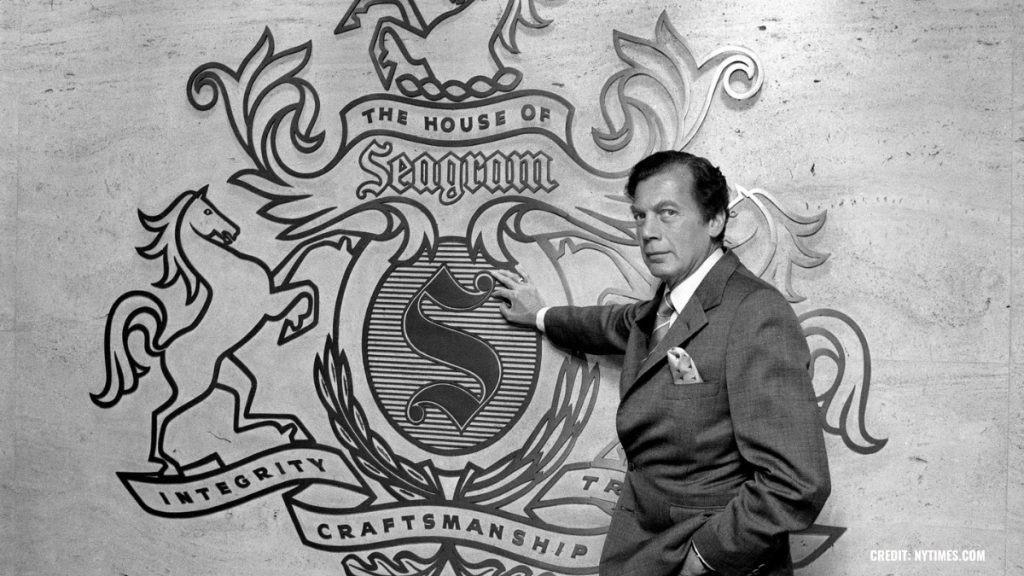
And Bronfman … He knew that some bad feeling had developed between Hollywood’s creative community and the Japanese owners of Universal. The thinking was that executives at Matsushita Electric had just not gotten what it took to make movies & TV shows.
And Edgar? Right from the get-go, he wanted to show that Seagrams was NOT going to be Matsushita Electric Redux. Bronfman was looking for a way to send a clear message to Hollywood’s creative community that Universal’s new owners got it. That they were willing to work with Hollywood to make the best possible movies & TV shows at Universal.
And how did Edgar decide to get this message across? By making a funny movie.
Zucker Commissions Trey Parker for “Your Studio & You”
Mind you, Bronfman himself didn’t make this film. The owner of Seagrams reached out to David Zucker. Who – after initially agreeing to produce this introduction-to-Universal film – then farmed out the production of the actual project to Trey Parker. Who – just two days before shooting was supposed to star on the Universal Lot – persuaded Matt Stone to come help him on this project.
Which brings us to “Your Studio and You.” Which is a parody of an educational film from the 1950s, right down to being shot in black & white and featuring a very generic soundtrack.
Now what’s amazing about watching “Your Studio and You” today is that this 14-minute-long film features some of the biggest names working in Hollywood back in the mid-1990s. We’re talking about people like recent Golden Globe winner Demi Moore, Sylvester Stallone, Michael J. Fox and Angela Lansbury. Not to mention two of the most powerful men in all of Hollywood, Steven Spielberg & Jeffrey Katzenberg.
And what’s especially interesting about watch “Your Studio and You” is that – as you watch these performers go through their paces in this motion pictures (which – most of the time – involves doing some innocuous task while holding a Seagram’s wine cooler) – you often get the feeling that this star is not in on the gag.
So how did Matt & Trey get away with this? Simple. There was never actually a script for “Your Studio and You.”
Filming “Your Studio & You” at Universal Studios Hollywood
Mind you, David Zucker would always insist that there was. Especially when he’d phone up celebrities on the Universal Lot and say “Hey, I’m sending over a couple of college kids later today. They’re working with me on a new parody film. It’s something that we’re doing for the new owners of Universal. I need just a half hour of your time. We’re shooting something special for the party we’ll be holding when the Seagrams people first arrive at the Studio. Absolutely. You’ll definitely get an invite to that party. So can I count on you to help these kids out? Beautiful. They’ll be over there later this morning.”
And then Matt & Trey would show up and say “… Dang, Miss Lansbury. We’re sorry. We must have left our copy of the ‘Your Studio and You’ script back in our office. Which is clear on the other side of the Lot. So – rather than waste your time – why don’t we do this instead? Follow us over to the Psycho House. Where we’re then going to get footage of you painting the front porch on Mother Bates’ house while you say ‘Gosh, with all of the wonderful improvements going on around here, everyone is going to want to work at Universal.’ Oh, and can we also get you to wear this button on the front of your blazer which reads ‘Universal is A-OK’ ? “

And over & over again, the biggest names who were working for Universal at that time took part in the production of “Your Studio & You” because A) David Zucker vouched for Matt Stone & Trey Parker and B) this was something that was being made for the new owners of Universal. And it’s just natural to want to get in good with the new boss.
Steven Spielberg, Jeffery Katzenberg, and Jaws
But no one at Universal anticipated that “Your Studio & You” would wind up being as sharp edged as the finished product turned out to be. I mean, it’s one thing to bite the hand that feeds you. But “Your Studio & You” ? It doesn’t just bite the hand. It takes the hand off at the wrist.
It’s a brutally funny film. With one of the meanest moments reserved for Steven Spielberg, who plays a driver on the Universal Studio Tour who’s trying to persuade a tram full of bored tourists (one of whom is played by Jeffery Katzenberg) that the “Shark Attack” scene down by Jaws Lagoon is actually exciting.
Spielberg actually says lines like “ … Whoa, whoa. What is going on here? Ladies and gentlemen, this never happens. Look out! It’s a shark! Whoa, that is one big scary shark.”

Mind you, as footage of this mechanical shark repeatedly coming up out of the water is shown, “Your Studio & You” ‘s off-screen narrator (who is voiced by Trey Parker says):
“But what about tomorrow? If we don’t keep in step with the times, things that were once neat and thrilling can become old and stupid.”
“Your Studio & You” Reception
This film was supposed to be shown only once at the welcoming party for Seagrams executive on the Universal Lot. And I’m told that – when Edgar Bronfman saw the finished product at that party – he reportedly turned to David Zucker and said “ … That’s a little more mean-spirited that I think it needed to be.”
And with that, “Your Studio & You” was supposed to go back into the Universal vault, never to be seen again. But when “South Park” debuted on Comedy Central in August of 1997 and then became a sensation for its biting humor, there was suddenly a lot of interest in what else Matt & Trey had done. Which is why copies of “The Spirit of Christmas” began to circulate. And – over time – copies of “Your Studio & You” began to bubble up.
Which – as Stone & Parker have repeatedly pointed out – was just not supposed to happen. Largely because none of the celebrities who appeared in “Your Studio & You” had never signed releases for Universal’s legal department. Because – again – this was for a movie that was only going to be shown once at a private function on the Universal Lot.
Matt mentioned (as part of a career retrospective at the Paley Center in LA back in 2000) that “ … they wouldn’t even let us keep a copy of the finished film.”
It’s a funny but brutal movie. And worth taking a look at today especially if you’re a theme park history buff because it shows Universal Studios Hollywood’s “Jurassic Park: The Ride” still under construction on the Lower Lot. That attraction would finally open to the public in June of 1996.
“Your Studio & You” became a lot easier to see after Seagrams sold off its share of Universal to Vivendi in 2000. Copies began propagating online after that. Though Universal Legal will periodically make an effort to get the latest copy of “Your Studio & You” taken off the Internet because – again – none of the performers who appear on camera ever signed the proper releases and/or were paid for their efforts.
That said, if you’re up for a mean-spirited laugh, “Your Studio & You” is well worth 14 minutes of your time. That said, once you watch this thing, be warned:
- You’re immediately going to be thirsty for a Seagram’s wine cooler
- And you’re going to have a sudden desire to go out & buy a porcelain deer.
Theme Parks & Themed Entertainment
Disney and Macy’s 90-Year Thanksgiving Day Parade Partnership: From Mickey’s First Balloon to Minnie’s Big Debut
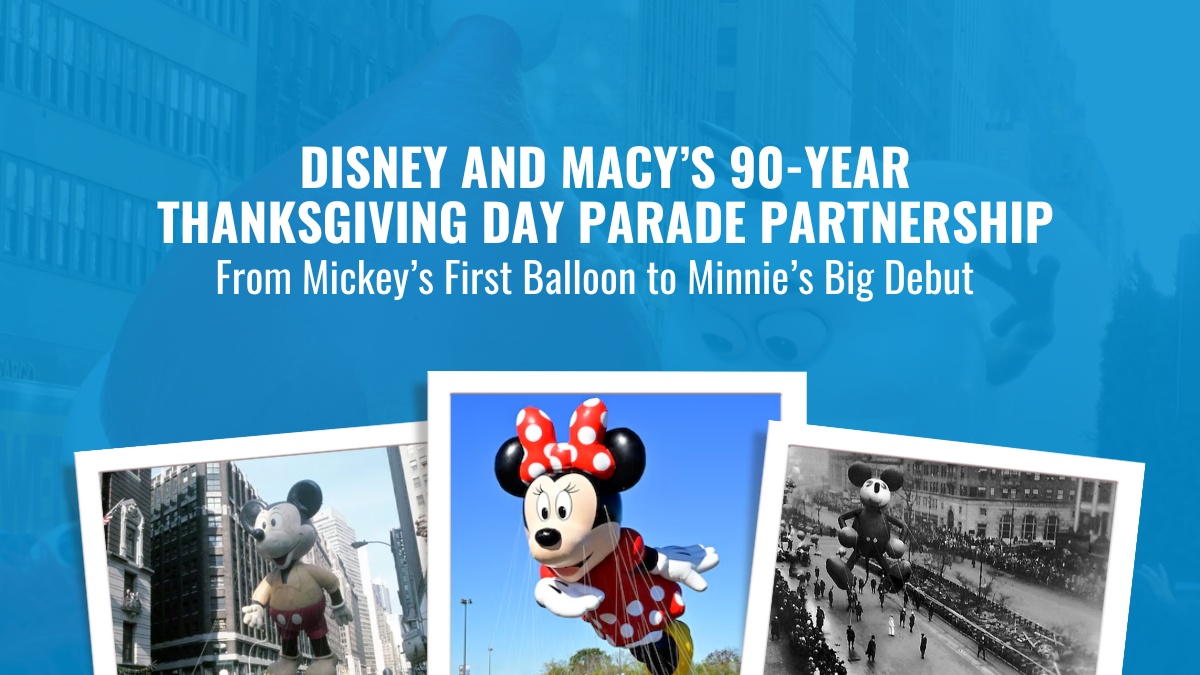
Now, folks, if you’re like me, Thanksgiving just wouldn’t be the same without a coffee, a cozy seat, and Macy’s Thanksgiving Day Parade on the TV. And if you’re really like me, you’re watching for one thing: Disney balloons floating down 34th Street. Ever wondered how Mickey, Donald, and soon Minnie Mouse found their way into this beloved New York tradition? Well, grab your popcorn because we’re diving into nearly 90 years of Disney’s partnership with Macy’s.
The Very First Parade and the Early Days of Balloons
The Macy’s Thanksgiving Day Parade goes way back to 1924, but if you can believe it, balloons weren’t part of the festivities until 1927. That first lineup included Felix the Cat, a dragon, and a toy soldier, all towering above the crowds. Back then, Macy’s had a pretty wild idea to end the parade: they would let the balloons drift off into the sky, free as birds. But this wasn’t just Macy’s feeling generous. Each balloon had a message attached, offering a $100 reward (about $1,800 in today’s dollars) for anyone who returned it to the flagship store on 34th Street.
And here’s where it gets interesting. This tradition carried on for a few years, right up until 1932, when Felix the Cat almost took down a plane flying over New York City! Imagine that—you’re flying into LaGuardia, and suddenly, there’s a 60-foot balloon drifting toward your wing. Needless to say, that was the end of Macy’s “fly away” stunt, and from then on, the balloons have stayed firmly grounded after the parade ends.

1934: Mickey Mouse Floats In, and Disney Joins the Parade
It was 1934 when Mickey Mouse finally made his grand debut in the Macy’s parade. Rumor has it Walt Disney himself collaborated with Macy’s on the design, and by today’s standards, that first Mickey balloon was a bit of a rough cut. This early Mickey had a hotdog-shaped body, and those oversized ears gave him a slightly lopsided look. But no one seemed to mind. Mickey was there, larger than life, floating down the streets of New York, and the crowd loved him.
Mickey wasn’t alone that year. He was joined by Pluto, Horace Horsecollar, and even the Big Bad Wolf and Practical Pig from The Three Little Pigs, making it a full Disney lineup for the first time. Back then, Disney wasn’t yet the entertainment powerhouse we know today, so for Walt, getting these characters in the parade meant making a deal. Macy’s required its star logo to be featured on each Disney balloon—a small concession that set the stage for Disney’s long-standing presence in the parade.
Duck Joins and Towers Over Mickey
A year later, in 1935, Macy’s introduced Donald Duck to the lineup, and here’s where things got interesting. Mickey may have been the first Disney character to float through the parade, but Donald made a huge splash—literally. His balloon was an enormous 60 feet tall and 65 feet long, towering over Mickey’s 40-foot frame. Donald quickly became a fan favorite, appearing in the lineup for several years before being retired.
Fast-forward a few decades, and Donald was back for a special appearance in 1984 to celebrate his 50th birthday. Macy’s dug the balloon out of storage, re-inflated it, and sent Donald down 34th Street once again, bringing a bit of nostalgia to the holiday crowd.
A Somber Parade in 2001
Now, one of my most memorable trips to the parade was in 2001, just weeks after the 9/11 attacks. Nancy and I, along with our friends, headed down to New York, and the mood was something I’ll never forget. We watched the start of the parade from Central Park West, but before that, we went to the Museum of Natural History the night before to see the balloons being inflated. They were covered in massive cargo nets, with sandbags holding them down. It’s surreal to see these enormous balloons anchored down before they’re set free.
That year, security was intense, with police lining the streets, and then-Mayor Rudy Giuliani rode on the Big Apple float to roaring applause. People cheered his name, waving and shouting as he passed. It felt like the entire city had turned out to show their resilience. Even amidst all the heightened security and tension, seeing those balloons—brought a bit of joy back to the city.

Balloon Prep: From New Jersey’s MetLife Stadium to California’s D23 Expo
Each year before the parade, Macy’s holds a rehearsal event known as Balloon Fest at MetLife Stadium in New Jersey. This is where handlers get their first crack at guiding the balloons, practicing with their parade masters, and learning the ropes—literally. It’s an entire production unto itself, with dozens of people rehearsing to make sure these enormous inflatables glide smoothly down the streets of New York on parade day.
In 2015, Macy’s took the balloon show on the road, bringing their Buzz Lightyear balloon out to California for the D23 Expo. I was lucky enough to be there, and watching Buzz get inflated piece by piece in the Anaheim Convention Center parking lot was something to behold. Each section was filled with helium in stages, and when they got around to Buzz’s lower half, well, there were more than a few gas-related jokes from the crowd.
These balloons seem to have a personality all their own, and seeing one like Buzz come to life up close—even outside of New York—had all the excitement and anticipation of the real deal.

Mickey’s Comeback as a Bandleader and Sailor Mickey
After a long hiatus, Mickey Mouse made his return to the Macy’s parade in 2000, this time sporting a new bandleader outfit. Nine years later, in 2009, Sailor Mickey joined the lineup, promoting Disney Cruise Line with a nautical twist. Over the past two decades, Disney has continued to enchant parade-goers with characters like Buzz Lightyear in 2008 and Olaf from Frozen in 2017. These balloons keep Disney’s iconic characters front and center, drawing in both longtime fans and new viewers.
But ever wonder what happens to the balloons after they reach the end of 34th Street? They don’t just disappear. Each balloon is carefully deflated, rolled up like a massive piece of laundry, and packed into storage bins. From there, they’re carted back through the Lincoln Tunnel to Macy’s Parade Studio in New Jersey, where they await their next flight.

Macy’s Disney Celebration at Hollywood Studios
In 1992, Macy’s took the spirit of the parade down to Disney-MGM Studios in Orlando. After that year’s parade, several balloons—including Santa Goofy, Kermit the Frog, and Betty Boop—were transported to Hollywood Studios, re-inflated, and anchored along New York Street as part of a holiday display. Visitors could walk through this “Macy’s New York Christmas” setup and see the balloons up close, right in the middle of the park. While this display only ran for one season, it paved the way for the Osborne Family Spectacle of Dancing Lights, which became a holiday staple at the park for years to come.

Minnie Mouse’s Long-Awaited Debut in 2024
This year, Minnie Mouse will finally join the parade, making her long-overdue debut. Macy’s is rolling out the red carpet for Minnie’s arrival with special pop-up shops across the country, where fans can find exclusive Minnie ears, blown-glass ornaments, T-shirts, and more to celebrate her first appearance in the Thanksgiving Day Parade.

For those lucky enough to catch the parade this year, you’ll see Minnie take her first float down 34th Street, decked out in her iconic red bow and polka-dot dress. Macy’s and Disney are also unveiling a new Disney Cruise Line float honoring all eight ships, including the latest, the Disney Treasure.
As always, I’ll be watching from my favorite chair, coffee in hand, as Minnie makes her grand entrance. The 98th annual Macy’s Thanksgiving Day Parade airs live on NBC, and it’s a tradition you won’t want to miss—whether you’re on 34th Street or tuning in from home.
-
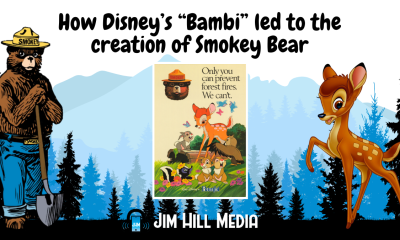
 Film & Movies12 months ago
Film & Movies12 months agoHow Disney’s “Bambi” led to the creation of Smokey Bear
-

 Theme Parks & Themed Entertainment7 months ago
Theme Parks & Themed Entertainment7 months agoDisney’s Forgotten Halloween Event: The Original Little Monsters on Main Street
-

 Theme Parks & Themed Entertainment8 months ago
Theme Parks & Themed Entertainment8 months agoThe Story of Mickey’s Not-So-Scary Halloween Party: From One Night to a Halloween Family Tradition
-

 Film & Movies7 months ago
Film & Movies7 months agoHow “An American Tail” Led to Disney’s “Hocus Pocus”
-

 Theme Parks & Themed Entertainment5 months ago
Theme Parks & Themed Entertainment5 months agoDisney and Macy’s 90-Year Thanksgiving Day Parade Partnership: From Mickey’s First Balloon to Minnie’s Big Debut
-

 Television & Shows3 months ago
Television & Shows3 months agoHow the Creators of South Park Tricked A-List Celebrities to Roast Universal – “Your Studio & You”
-

 History2 months ago
History2 months agoThe Super Bowl & Disney: The Untold Story Behind ‘I’m Going to Disneyland!’
-

 Podcast3 weeks ago
Podcast3 weeks agoEpic Universal Podcast – Aztec Dancers, Mariachis, Tequila, and Ceremonial Sacrifices?! (Ep. 45)

